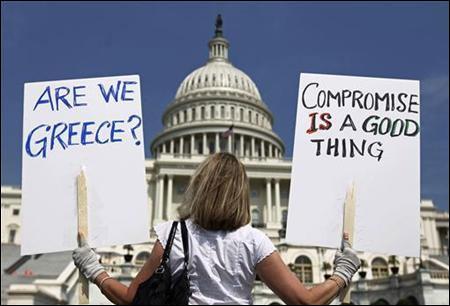 | « Back to article | Print this article |
Why things in US might be worse than Europe
"So things are getting worse in Europe," she said.
"Let me tell you a small story I read on a blog recently," I replied.
"What story?"
"Seth Godin, one of the world's premier brand experts and famous blogger, wrote a blog on the rock band The Rolling Stones, a while back."
"But why are we talking The Rolling Stones?" she asked. "I am talking economics, you're talking rock."
"Men are from Mars, Women are from Venus!"
"Eh?"
"Never mind. So in this blog Godin writes "Keith Richards (guitarist and vocalist of The Rolling Stones) tells a great story about Charlie Watts, legendary drummer for the Stones. After a night of drinking, Mick (Jagger, the lead vocalist of The Rolling Stones) saw Charlie asleep and yelled, "Is that my drummer? Why don't you get your arse down here?" Richards continues, "Charlie got dressed in a Savile Row suit, tie, shoes, shaved, came down, grabbed him and went boom!Don't ever call me "your drummer" again. You're my ... singer. No drums, noStones."
"No drums, no Stones?" she asked. "What does that mean?"
"What I am trying to say is that at times there is a need to look at things differently."
"Differently?"
"Yes with all this brouhaha about Europe, people have forgotten the United States(US)," I explained.
"So you mean that there is no problem in Europe?"
"Of course not. But just because there are problems in Europe doesn't mean things are fine in the US."
"So what you mean is that with all the attention being paid on Europe, people are ignoring the issues in the US?"
"Right. In fact, the unfunded liabilities of the US government are huge."
"Now what are unfunded liabilities?" she asked.
"Let us say you want to retire 10 years from now," I started to explain.
"Ten years? Why should I retire so early?" she interrupted.
"It's an exampleyaar."
"Oh."
Click on NEXT for more...
Why things in US might be worse than Europe
"So let us say you want to retire 10 years from now. You feel that an income of around Rs 800,000 per year should be enough for you to sail through."
"Bus.That's too low an amount."
"To earn an income of Rs 800,000 per year you would need to build a corpus of Rs 1 crore, assuming that you manage to get an interest of 8 per cent on the corpus you build. But this Rs 1 crore (Raillion) is not going to come out of thin air."
"Yeah."
"So you will have to save regularly to build that Rs 1 crore corpus," I said.
"Yes.Paisa kamane ke liye bhi paisa chahiye," she replied. "But what is all this got to do with the US government?"
"Well the logic is the same. What works for you also works for the government. The government gives a pension to people when they retire. If a certain number of people are expected to retire ten years from now, then they would have to be paid a certain amount of pension. While estimating the exact amount is difficult, estimates can be made. But what we know for sure is that money is to be saved now so that citizens can be paid pensions later."
"Yup. So what was that part about the unfunded bit?" she asked.
"If governments don't invest the right amount from now on, which a lot of them don't including the US government, they will have to pay these citizens by borrowing money later. And if pensions cannot be funded through the investments already made, they are said to be 'unfunded'."
"Hmmm."
"I was reading this interesting book Ponzi Power by Mitch Feierstein. He writes, "Using proper accounting methods...the true value of the state and municipal pension liability is at $5.2trilion. When you deduct the $1.94trillion of pension assets that have already been set aside, you get a net liability of $3.26trillion."
"These are big numbers," she said.
"Yes. Other than this the US government already has an existing debt of around $14.6trillion."
"So that's about it?"
Why things in US might be worse than Europe
"Feierstein also points out that the social security programme of the US government is also underfunded to the extent of $18.8trillion.
The underfunding in Medicare, the health insurance programme amounts to around $38.5 trillion. So if you add all of this up the number comes to a whopping $75.2trillion and that is what Feierstein feels the US government owes to others like governments and its own citizens.
To give you a sense of proportion, the US yearly gross domestic product (GDP) is at $15trillion. The GDP of the entire world is around $60trillion. So these are big numbers we are talking about"
"But isn't that an estimate?" she asked.
"Yes it is. But it has been drawn partly from documents of the US government. The private estimates are worse.
Economist Edward Chancellor writes in a report "One estimate of US healthcare and pension liabilities runs to 7 times the country's GDP." This estimate suggests that the US government owes more than $100trillion. There is no single precise measure of the indebtedness of the US government. But there are big numbers and there are bigger numbers."
"Ha Ha!"
"Laurence Kotlikoff of Boston University has made a lifetime study of the present value of unfunded commitments using data from the US Congressional and Budget Office. He puts the true level of US indebtedness to around $202trillion."
"Oh my god!"
"Yes."
"So what is the way out?"
"Well all these welfare schemes will have to be dramatically cut and that may not be a politically popular move. Otherwise the US debt is going to go up dramatically from its current levels."
"But I am confused. If things are so bad, why does the US dollar continue to be seen as a safe haven?"
"Well, for the simple reason that dollar is the international reserve currency, and if things become too bad the US can always print it to repay. Hence every time there is a hint of a crisis anywhere in the world more money moves to the dollar."
"But that's stupid."
"Yes it is. But remember as the economist Herbert Stein once wrote, "If something cannot go on forever, it will stop."
"When will it stop?"
"Let me end with a line from John Maynard Keyens. As he famously said"markets can remain irrational longer than you can remain solvent!" And as the first rule of forecasting is that give them the forecast or the date, but never both!"
Vivek Kaul is a writer and can be reached at vivek.kaul@gmail.com


